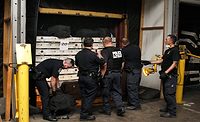Adapting to Emerging Threats: What’s Next for Security Screening Technology?

Increasing threat levels and advancements in technology mean the security landscape is constantly evolving. Every high-profile incident over the years, from hijackings to bombings, has brought new intelligence to light about the motives and methods of attackers – which has helped shape the technology we see today.
When a bomb hidden in a cassette player destroyed a plane in the 1988 Lockerbie air disaster, 100 per cent hold baggage screening was consequently rolled out. And airport security measures were ramped up considerably worldwide following the 9/11 attacks in 2001.
But it’s not just the incidents that involve severe damage to infrastructure or significant fatalities that are having an impact on security; plots, failed attempts and even pranks are also shaping subsequent security measures.
Just look at the drone sightings which brought Gatwick to a standstill over the 2018 Christmas period and temporarily halted Heathrow flights at the start of 2019. As a result, bosses at both airports have now invested millions in military-grade anti-drone technology in order to prevent future attacks and threats to operational safety.
Evolving targets
If there’s one thing that’s become apparent over recent years, it’s that terrorists are no longer just targeting critical infrastructure. Now more than ever, there is a greater focus on civilians. Which is why ‘soft targets’ such as arenas, concert venues, stadiums and hotels are becoming increasingly common targets.
Venues such as these, where large crowds gather, present a number of challenges when it comes to conducting rapid security screening without compromising safety. Equally, entertainment and hospitality events such as red-carpet premieres also call for heightened security which is both highly effective and efficient so as to avoid disrupting the main event.
As the threat level grows, these environments increasingly require advanced security screening solutions which are rapidly deployable and non-obtrusive – and which can be used in a range of different scenarios, enabling large volumes of people and vehicles to be checked swiftly yet thoroughly.
Ease of transportation and installation is also essential in these high-risk settings to ensure the security zone can be set up a safe distance away from the event or venue perimeter, without the need for specialist equipment or personnel.
Looking ahead
Artificial intelligence (AI) has long been seen as a bit of a fad, but technological developments mean it is becoming more of a reality – particularly in the security sector. For example, machine learning techniques are helping to automatically identify concealed threats, enabling real-time screening as scanners quickly ‘learn’ the difference between prohibited and ordinary items. Picking up explosives and firearms while ignoring non-dangerous items such as keys and belt buckles which users may be carrying.
This means items that previously needed to be scanned separately, such as laptops or phones, can be kept in bags or on the person as they pass through security checkpoints – helping to reduce the risk of inconvenient false alarms which slow down the screening process.
Crucially, these AI systems also improve as more and more information is fed into them – meaning the technology will only become more advanced and prominent within scanning technology in the future. As such, the next few years will undoubtedly see an increase in these types of technologies as companies continue to expand their product portfolios with innovative solutions that draw on the latest AI developments to meet the evolving demands of the security screening industry.
Looking for a reprint of this article?
From high-res PDFs to custom plaques, order your copy today!






